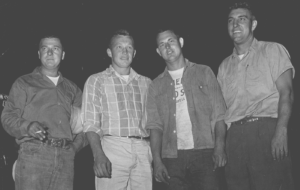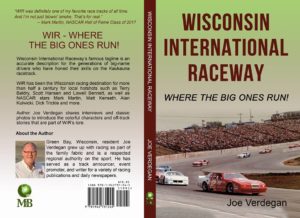The Vault
REMEMBERING “SMILIN’ CLYDE” SCHUMACHER
Posted on: Tuesday December 14, 2021
The following is a chapter from the 2016 release “Wisconsin International Raceway – Where The Big Ones Run”
Clyde Schumacher was one of the first of dozens of drivers I interviewed for this book. He possessed a great sense of humor and was a great story teller.
Enjoy this read and learn about the career of one of the founding fathers of WIR. Rest in peace Clyde.

Smilin’ Clyde Schumacher (far right) poses with fellow racers (left to right) Bucky Wagner, Roger Paul and Gene Wheeler in the early 1960s. (Clyde Schumacher collection)
According to “Smilin’ Clyde” Schumacher, KK Sports Arena (later known as Wisconsin International Raceway) originally was built out of spite.
Schumacher, now eighty-six years old, earned the nickname “Smilin’
Clyde” for his wide, ear-to-ear smile that never seemed to disappear, no matter what the circumstances of the day or night. The lifelong native of Kimberly was one of the founding fathers of KK Sports Arena.
Schumacher was assigned the number 71 by the track scorers. “There were that many cars back then you got assigned a number,” he said.
Schumacher credits many of his speed secrets to Alan Pingl, a member of another pit crew. “Alan gave me some tips with setting the points on the distributor and she ran just like a charm after that.”
us.”
Creek and Oshkosh Raceway before getting involved with KK Sports
Arena. “Oshkosh had absolutely huge crowds – I remember that,” recalled Schumacher. “You had to be there two hours early to get a seat. It was a very good deal. I set track records there. I got the fast time thing down.”
At the end of one night of racing, track officials from the Fox Valley
Stock Car Club decided to tear down Schumacher’s engine. “This was late at night. They went to a nearby service station, yanked
the motor and decided to pull it apart,” Schumacher said. “They thought we were illegal. They popped the manifold and the heads off. They couldn’t find anything wrong with the engine. The motor was on the hoist. When they put the motor back in they found a chopped flywheel. It was cut in half to cut the weight down. That was illegal. They barred me from racing there. And that’s what prompted me to go and help build KK Sports Arena.”
DeLeeuw at some farmland he owned near Highway 55 and KK in Kaukauna.
DeLeeuw had the land. Joe Van Daalwyk had the construction company.
helped raise five kids and even played trombone in a five-piece Dixie band called Bob Gordon’s. “We had a blast over the years racing with the guys,” said Schumacher. “Whichever driver got fast time, they had to always buy the first round of drinks for everybody at the saloon afterwards. Then whoever won the feature bought the second round.”
After the bars closed, Schumacher would invite everyone to his humble abode in Kimberly. “Heck, those guys would tow their cars and we’d have five or six race cars lined up and down our street. Even though we’d mix it up on the track, we’d party hard and drink beer a lot of times until the sun came up.”
Schumacher was one of the best when it came to time trials, often nailing fast time and breaking many track records at ovals across Wisconsin. Races were handicapped in the 1960s, and the fast timer usually had to start from “the back of the bus” in the last row. As such, a driver really earned his feature wins. Other drivers would often sandbag, or intentionally qualify at a slower time, in an effort to land a spot in or near the front row.
some ladies as well. “Women were always sending him letters in the mail with lip prints and perfume on them,” said Joan Schumacher, Clyde’s wife. “Apparently they didn’t know he was a happily married man with five children. We’d both laugh about it.”
me,” Schumacher chuckled. “He went after me through the back window of my car. But I grabbed him by the neck and told him he wasn’t in a real good position to do that.”
Compared to the era in which Schumacher found much of his success, the modern era of stock car racing has become very expensive. “It wasn’t much different back then – it was all relative,” said Schumacher. “I do remember breaking even one year. I always split the prize money with my car owners with a 50/50 split.”
even going to race my last year, and I went to my buddy Cliff Wydeven – he was an insurance guy. I told him I didn’t have the cash to race. I told him I needed five or six grand just to get a new car built. Cliff opened a drawer, and there were stacks and stacks of 100-dollar bills. Wydeven said, ‘Take whatever you need to get your car on the track.’ He was a great sponsor.”
number 30 car – the Terry Besaw-owned Ford Torino Schumacher helped prepare. Smith won over thirty features with that racer.
Schumacher has fond memories from his fifteen-year racing career. “The camaraderie was great – we had wonderful friends,” he said. “Even though I was a fourth heat guy, I would mingle and talk with the first heat guys. It didn’t matter to me. Some of those faster guys thought they were better than others. Not me. We used to stop at Vic’s all the time in Bonduel after the races. We’d stop there with the Trudell clan out of Appleton. Just fun times all the way around.”
other pals with instruments. “One Saturday night, we all started playing When the Saints Come Marching In. We walked out on Main Street and the whole bunch of us paraded into another bar across the street. We just had a blast.”
smiling and don’t let this world bother you.”

This book available for purchase. Simply click on the “books” tab on the upper left corner of this website.


